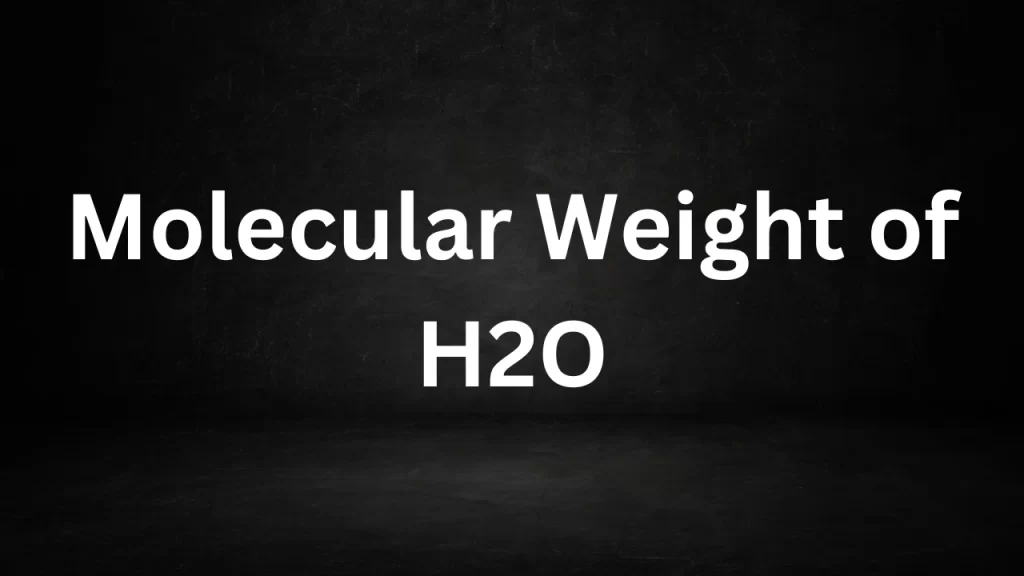Tag: molecular weight of h2o
Molecular Weight of H2O
Molecular Weight of H2O: Water, Earth’s most abundant and vital substance, consists of molecules possessing a distinct molecular weight critical for all life forms.
Understanding the molecular weight of water, represented as H2O, is fundamental not only in chemistry but also in various scientific and practical applications.
This article delves into the concept of H2O’s molecular weight, its calculation, and its importance across various fields of science and industry.

Molecular Weight of H2O
The Composition of Water:
Water, with the chemical formula H2O, consists of two hydrogen atoms (H) covalently bonded to a single oxygen atom (O). These atoms come together to form a water molecule. This molecular arrangement gives water its unique properties, such as its ability to dissolve a wide range of substances and its high heat capacity.
Calculating the Molecular Weight of H2O:
The molecular weight of a substance is defined as the mass of one mole of that substance, expressed in grams per mole (g/mol). To calculate the molecular weight of H2O, we consider the atomic masses of its constituent elements, hydrogen (H) and oxygen (O).
- The atomic mass of hydrogen (H) is approximately 1.01 g/mol.
- The atomic mass of oxygen (O) is approximately 16.00 g/mol.
To find the mole weight of H2O, we add the atomic masses of two hydrogen atoms and one oxygen atom:
Mole Weight of H2O (g/mol) = (2 × Atomic Mass of Hydrogen) + (1 × Atomic Mass of Oxygen)
Mole Weight of H2O ≈ (2 × 1.01 g/mol) + (1 × 16.00 g/mol) ≈ 18.02 g/mol
So, the mole weight of H2O (water) is approximately 18.02 g/mol.
Significance of Molecular Weight in Chemistry:
- Stoichiometry: Mole weight is crucial in stoichiometry, which involves determining the quantities of reactants and products in chemical reactions.
- Molarity: In chemistry, molarity (M) is a measure of the concentration of a substance in a solution. Molecular weight serves as a key factor in calculating molarity, a measure expressed as moles per liter (mol/L).
- Chemical Equations: Mole weight plays a vital role in balancing chemical equations to ensure the conservation of mass.
Real-World Applications:
- Laboratory Work: Chemists and researchers use the molecular weight of substances like water in laboratory experiments and analyses.
- Pharmaceuticals: Molecular weight is critical in pharmaceuticals for dosage calculations and drug formulation.
- Environmental Science: Understanding the molecular weight of water is essential in environmental science for assessing water quality and pollutant concentrations.
Conclusion:
The mole weight of H2O, approximately 18.02 g/mol, is a fundamental concept in chemistry and has broad applications in various scientific and practical fields. Whether in the laboratory, pharmaceutical industry, or environmental science, knowing the molecular weight of water is essential for precise measurements and calculations. It is a reminder of the simple yet profound principles that govern the behavior of substances at the molecular level, shaping our understanding of the world around us.
Read More
- Molecular Weight Of K2Cr2O7
- Molecular Weight Of Phosphorus
- Molecular Weight Of SO2
- Molecular Weight of Na2CO3
- Molecular Mass Of Sodium
Frequently Asked Questions (FAQs) on Molecular Weight of H2O
Q1: What is the molecular weight of H2O (water)?
A1: The mole weight of H2O, which is water, is approximately 18.02 grams per mole (g/mol). This value is calculated by summing the atomic masses of two hydrogen atoms (H) and one oxygen atom (O) in a water molecule.
Q2: Why is knowing the molecular weight of H2O important?
A2: Understanding the mole weight of H2O is crucial in various scientific and practical applications. It is used in chemistry for stoichiometry, molarity calculations, and balancing chemical equations. In fields like environmental science and pharmaceuticals, it helps in precise measurements and dosage calculations.
Q3: Does the molecular weight of H2O change with temperature or pressure?
A3: The molecular weight of H2O remains constant regardless of temperature or pressure. It is a fixed value based on the atomic masses of hydrogen and oxygen.
Q4: How is the molecular weight of H2O calculated?
A4: The mole weight of H2O is calculated by adding the atomic masses of its constituent elements. The atomic mass of hydrogen (H) is approximately 1.01 g/mol, and the atomic mass of oxygen (O) is approximately 16.00 g/mol. Therefore, for water (H2O), it is approximately 18.02 g/mol.
Q5: Can the molecular weight of H2O vary in different types of water?
A5: The mole weight of H2O is the same for all types of water, including distilled water, tap water, and seawater. It is a constant value based on the chemical composition of water, which consists of two hydrogen atoms and one oxygen atom per molecule.
Molecular Mass of Water
Molecular Mass of Water: Water is a fundamental and ubiquitous substance in our world, covering about 71% of the Earth’s surface and making up a significant portion of living organisms.
At a molecular level, water consists of two hydrogen atoms and one oxygen atom bonded together, represented as H2O. In this article, we will explore the molecular mass of water and its significance in chemistry and everyday life.
Molecular Mass of Water
Molecular Composition of Water
Water’s molecular formula, H2O, describes the specific arrangement of its atoms. In a water molecule, two hydrogen atoms (H) are covalently bonded to one oxygen atom (O). This simple structure belies the remarkable properties and importance of water in various natural and chemical processes.
Molecular Mass of Water
The molecular mass of a substance is the sum of the atomic masses of all the atoms in a molecule. To calculate the molecular mass of water (H2O), we add the atomic masses of its constituent elements:
- The atomic mass of hydrogen (H) is approximately 1 atomic mass unit (amu).
- The atomic mass of oxygen (O) is approximately 16 amu.
Therefore, the molecular mass of water is:
Molecular mass of H2O = (2 × Atomic mass of H) + Atomic mass of O Molecular mass of H2O = (2 × 1 amu) + 16 amu Molecular mass of H2O = 2 amu + 16 amu Molecular mass of H2O = 18 amu
The molecular mass of water is 18 atomic mass units (amu).
Significance of the Molecular Mass of Water
The molecular mass of water is a critical concept in chemistry and has several significant implications:
1. Stoichiometry:
In chemical reactions, the molecular mass of water is essential for stoichiometric calculations. It helps determine the quantities of reactants and products involved in a chemical reaction. As an illustration, in the reaction where hydrogen gas (H2) combines with oxygen gas (O2) to produce water (H2O), the mol. mass of water is employed to determine the stoichiometry of the reaction.
2. Concentrations and Solutions:
The molecular mass of water is employed for the computation of substance concentrations within solutions. The concept of molarity (moles of solute per liter of solution) relies on knowing the mol. mass of solutes, including water itself when it acts as a solvent.
3. Physical Properties:
Water’s mol mass contributes to its unique physical properties, such as its high boiling point, melting point, and heat capacity. These properties are essential for life and various industrial processes.
4. Environmental Science:
Understanding the mol mass of water is crucial in environmental science and ecology. It plays a role in the study of water pollution, the water cycle, and the behavior of substances dissolved in water bodies.
5. Health and Nutrition:
The mol mass of water is also relevant in health and nutrition. It is used to calculate the molecular mass of nutrients and substances in food and beverages, aiding in dietary planning and analysis.
6. Laboratory Techniques:
In laboratories, chemists use the mol mass of water to calibrate instruments, prepare solutions of known concentrations, and analyze samples using techniques like mass spectrometry and chromatography.
Conclusion
The mol mass of water, represented as H2O, is a fundamental concept in chemistry and plays a vital role in various scientific, industrial, and everyday applications. It not only defines the composition of water but also influences its physical and chemical properties. Understanding the mol mass of water is essential for stoichiometry, concentration calculations, environmental studies, and numerous other fields, underlining its significance in our understanding of the natural world and the chemical processes that govern it.
Read More
- Difference Between Cyclone And Hurricane
- Molecular Weight Of Na
- Molecular Mass Of O2
- Molecular Mass of H2
- Molecular Mass Of NH3
Frequently Asked Questions (FAQs) Mol Mass of Water
Q1: What is the mol mass of water (H2O)?
The mol mass of water (H2O) is 18 atomic mass units (amu). The determination of this value involves summing the atomic masses of two hydrogen atoms (each roughly 1 amu) and one oxygen atom (approximately 16 amu) within a water molecule.
Q2: Why is the mol mass of water important in chemistry?
The mol mass of water holds significant importance in chemistry as it plays a pivotal role in stoichiometry, where it helps ascertain the amounts of substances involved in chemical reactions, both as reactants and products. It is also essential for calculating concentrations in solutions and plays a role in understanding the physical and chemical properties of water.
Q3: How is the molecular mass of water relevant in everyday life?
The mol. mass of water is relevant in everyday life in various ways. It contributes to the unique physical properties of water, such as its high boiling and melting points, which are essential for cooking and various industrial processes. Additionally, it is important in health and nutrition for calculating nutrient content in foods and beverages.
Q4: Is the molecular mass of water used in environmental science?
Certainly, the molecular mass of water finds application in the field of environmental science. It is relevant in studies of water pollution, the water cycle, and the behavior of substances dissolved in water bodies. Understanding water’s molecular mass is crucial for assessing its impact on the environment.
Q5: How is the molecular mass of water determined experimentally?
The molecular mass of water can be determined experimentally using various analytical techniques, including mass spectrometry and chromatography. These methods involve measuring the mass-to-charge ratios of H2O molecules and their fragments, allowing for precise determination of molecular mass.
